Jintao Cheng
AVAM: Universal Training-free Adaptive Visual Anchoring Embedded into Multimodal Large Language Model for Multi-image Question Answering
Aug 25, 2025Abstract:The advancement of Multimodal Large Language Models (MLLMs) has driven significant progress in Visual Question Answering (VQA), evolving from Single to Multi Image VQA (MVQA). However, the increased number of images in MVQA inevitably introduces substantial visual redundancy that is irrelevant to question answering, negatively impacting both accuracy and efficiency. To address this issue, existing methods lack flexibility in controlling the number of compressed visual tokens and tend to produce discrete visual fragments, which hinder MLLMs' ability to comprehend images holistically. In this paper, we propose a straightforward yet universal Adaptive Visual Anchoring strategy, which can be seamlessly integrated into existing MLLMs, offering significant accuracy improvements through adaptive compression. Meanwhile, to balance the results derived from both global and compressed visual input, we further introduce a novel collaborative decoding mechanism, enabling optimal performance. Extensive experiments validate the effectiveness of our method, demonstrating consistent performance improvements across various MLLMs. The code will be publicly available.
A Pseudo Global Fusion Paradigm-Based Cross-View Network for LiDAR-Based Place Recognition
Aug 12, 2025Abstract:LiDAR-based Place Recognition (LPR) remains a critical task in Embodied Artificial Intelligence (AI) and Autonomous Driving, primarily addressing localization challenges in GPS-denied environments and supporting loop closure detection. Existing approaches reduce place recognition to a Euclidean distance-based metric learning task, neglecting the feature space's intrinsic structures and intra-class variances. Such Euclidean-centric formulation inherently limits the model's capacity to capture nonlinear data distributions, leading to suboptimal performance in complex environments and temporal-varying scenarios. To address these challenges, we propose a novel cross-view network based on an innovative fusion paradigm. Our framework introduces a pseudo-global information guidance mechanism that coordinates multi-modal branches to perform feature learning within a unified semantic space. Concurrently, we propose a Manifold Adaptation and Pairwise Variance-Locality Learning Metric that constructs a Symmetric Positive Definite (SPD) matrix to compute Mahalanobis distance, superseding traditional Euclidean distance metrics. This geometric formulation enables the model to accurately characterize intrinsic data distributions and capture complex inter-class dependencies within the feature space. Experimental results demonstrate that the proposed algorithm achieves competitive performance, particularly excelling in complex environmental conditions.
KDMOS:Knowledge Distillation for Motion Segmentation
Jun 17, 2025Abstract:Motion Object Segmentation (MOS) is crucial for autonomous driving, as it enhances localization, path planning, map construction, scene flow estimation, and future state prediction. While existing methods achieve strong performance, balancing accuracy and real-time inference remains a challenge. To address this, we propose a logits-based knowledge distillation framework for MOS, aiming to improve accuracy while maintaining real-time efficiency. Specifically, we adopt a Bird's Eye View (BEV) projection-based model as the student and a non-projection model as the teacher. To handle the severe imbalance between moving and non-moving classes, we decouple them and apply tailored distillation strategies, allowing the teacher model to better learn key motion-related features. This approach significantly reduces false positives and false negatives. Additionally, we introduce dynamic upsampling, optimize the network architecture, and achieve a 7.69% reduction in parameter count, mitigating overfitting. Our method achieves a notable IoU of 78.8% on the hidden test set of the SemanticKITTI-MOS dataset and delivers competitive results on the Apollo dataset. The KDMOS implementation is available at https://github.com/SCNU-RISLAB/KDMOS.
You Sense Only Once Beneath: Ultra-Light Real-Time Underwater Object Detection
Apr 22, 2025Abstract:Despite the remarkable achievements in object detection, the model's accuracy and efficiency still require further improvement under challenging underwater conditions, such as low image quality and limited computational resources. To address this, we propose an Ultra-Light Real-Time Underwater Object Detection framework, You Sense Only Once Beneath (YSOOB). Specifically, we utilize a Multi-Spectrum Wavelet Encoder (MSWE) to perform frequency-domain encoding on the input image, minimizing the semantic loss caused by underwater optical color distortion. Furthermore, we revisit the unique characteristics of even-sized and transposed convolutions, allowing the model to dynamically select and enhance key information during the resampling process, thereby improving its generalization ability. Finally, we eliminate model redundancy through a simple yet effective channel compression and reconstructed large kernel convolution (RLKC) to achieve model lightweight. As a result, forms a high-performance underwater object detector YSOOB with only 1.2 million parameters. Extensive experimental results demonstrate that, with the fewest parameters, YSOOB achieves mAP50 of 83.1% and 82.9% on the URPC2020 and DUO datasets, respectively, comparable to the current SOTA detectors. The inference speed reaches 781.3 FPS and 57.8 FPS on the T4 GPU (TensorRT FP16) and the edge computing device Jetson Xavier NX (TensorRT FP16), surpassing YOLOv12-N by 28.1% and 22.5%, respectively.
Incorporating GNSS Information with LIDAR-Inertial Odometry for Accurate Land-Vehicle Localization
Mar 29, 2025Abstract:Currently, visual odometry and LIDAR odometry are performing well in pose estimation in some typical environments, but they still cannot recover the localization state at high speed or reduce accumulated drifts. In order to solve these problems, we propose a novel LIDAR-based localization framework, which achieves high accuracy and provides robust localization in 3D pointcloud maps with information of multi-sensors. The system integrates global information with LIDAR-based odometry to optimize the localization state. To improve robustness and enable fast resumption of localization, this paper uses offline pointcloud maps for prior knowledge and presents a novel registration method to speed up the convergence rate. The algorithm is tested on various maps of different data sets and has higher robustness and accuracy than other localization algorithms.
MambaFlow: A Novel and Flow-guided State Space Model for Scene Flow Estimation
Feb 24, 2025Abstract:Scene flow estimation aims to predict 3D motion from consecutive point cloud frames, which is of great interest in autonomous driving field. Existing methods face challenges such as insufficient spatio-temporal modeling and inherent loss of fine-grained feature during voxelization. However, the success of Mamba, a representative state space model (SSM) that enables global modeling with linear complexity, provides a promising solution. In this paper, we propose MambaFlow, a novel scene flow estimation network with a mamba-based decoder. It enables deep interaction and coupling of spatio-temporal features using a well-designed backbone. Innovatively, we steer the global attention modeling of voxel-based features with point offset information using an efficient Mamba-based decoder, learning voxel-to-point patterns that are used to devoxelize shared voxel representations into point-wise features. To further enhance the model's generalization capabilities across diverse scenarios, we propose a novel scene-adaptive loss function that automatically adapts to different motion patterns.Extensive experiments on the Argoverse 2 benchmark demonstrate that MambaFlow achieves state-of-the-art performance with real-time inference speed among existing works, enabling accurate flow estimation in real-world urban scenarios. The code is available at https://github.com/SCNU-RISLAB/MambaFlow.
Real-Time AIoT for UAV Antenna Interference Detection via Edge-Cloud Collaboration
Dec 04, 2024



Abstract:In the fifth-generation (5G) era, eliminating communication interference sources is crucial for maintaining network performance. Interference often originates from unauthorized or malfunctioning antennas, and radio monitoring agencies must address numerous sources of such antennas annually. Unmanned aerial vehicles (UAVs) can improve inspection efficiency. However, the data transmission delay in the existing cloud-only (CO) artificial intelligence (AI) mode fails to meet the low latency requirements for real-time performance. Therefore, we propose a computer vision-based AI of Things (AIoT) system to detect antenna interference sources for UAVs. The system adopts an optimized edge-cloud collaboration (ECC+) mode, combining a keyframe selection algorithm (KSA), focusing on reducing end-to-end latency (E2EL) and ensuring reliable data transmission, which aligns with the core principles of ultra-reliable low-latency communication (URLLC). At the core of our approach is an end-to-end antenna localization scheme based on the tracking-by-detection (TBD) paradigm, including a detector (EdgeAnt) and a tracker (AntSort). EdgeAnt achieves state-of-the-art (SOTA) performance with a mean average precision (mAP) of 42.1% on our custom antenna interference source dataset, requiring only 3 million parameters and 14.7 GFLOPs. On the COCO dataset, EdgeAnt achieves 38.9% mAP with 5.4 GFLOPs. We deployed EdgeAnt on Jetson Xavier NX (TRT) and Raspberry Pi 4B (NCNN), achieving real-time inference speeds of 21.1 (1088) and 4.8 (640) frames per second (FPS), respectively. Compared with CO mode, the ECC+ mode reduces E2EL by 88.9%, increases accuracy by 28.2%. Additionally, the system offers excellent scalability for coordinated multiple UAVs inspections. The detector code is publicly available at https://github.com/SCNU-RISLAB/EdgeAnt.
CV-MOS: A Cross-View Model for Motion Segmentation
Aug 25, 2024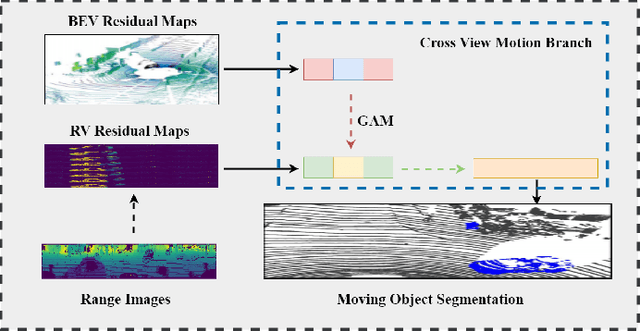
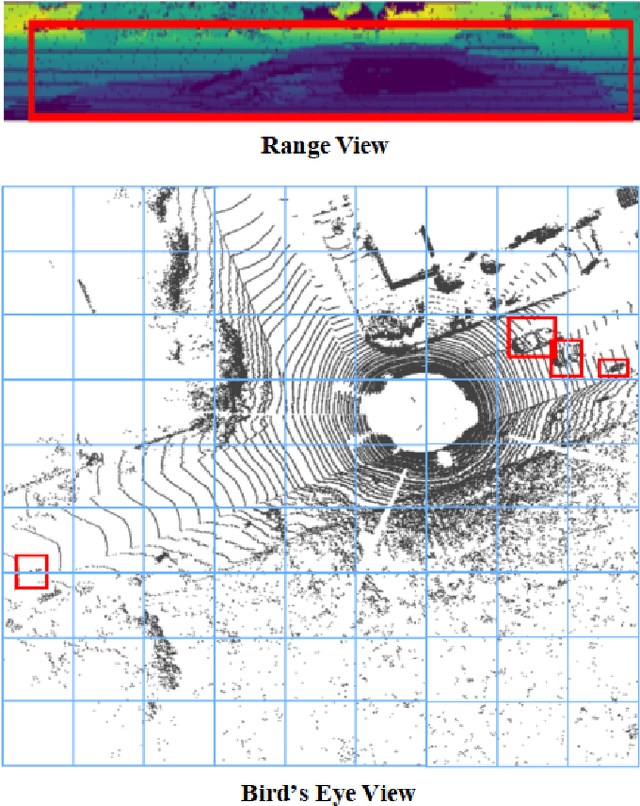
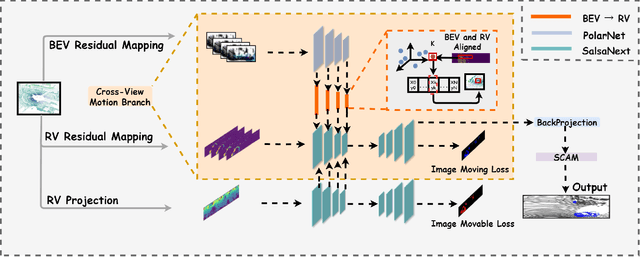
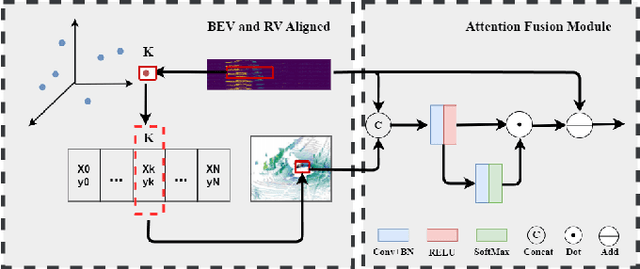
Abstract:In autonomous driving, accurately distinguishing between static and moving objects is crucial for the autonomous driving system. When performing the motion object segmentation (MOS) task, effectively leveraging motion information from objects becomes a primary challenge in improving the recognition of moving objects. Previous methods either utilized range view (RV) or bird's eye view (BEV) residual maps to capture motion information. Unlike traditional approaches, we propose combining RV and BEV residual maps to exploit a greater potential of motion information jointly. Thus, we introduce CV-MOS, a cross-view model for moving object segmentation. Novelty, we decouple spatial-temporal information by capturing the motion from BEV and RV residual maps and generating semantic features from range images, which are used as moving object guidance for the motion branch. Our direct and unique solution maximizes the use of range images and RV and BEV residual maps, significantly enhancing the performance of LiDAR-based MOS task. Our method achieved leading IoU(\%) scores of 77.5\% and 79.2\% on the validation and test sets of the SemanticKitti dataset. In particular, CV-MOS demonstrates SOTA performance to date on various datasets. The CV-MOS implementation is available at https://github.com/SCNU-RISLAB/CV-MOS
MV-MOS: Multi-View Feature Fusion for 3D Moving Object Segmentation
Aug 20, 2024



Abstract:Effectively summarizing dense 3D point cloud data and extracting motion information of moving objects (moving object segmentation, MOS) is crucial to autonomous driving and robotics applications. How to effectively utilize motion and semantic features and avoid information loss during 3D-to-2D projection is still a key challenge. In this paper, we propose a novel multi-view MOS model (MV-MOS) by fusing motion-semantic features from different 2D representations of point clouds. To effectively exploit complementary information, the motion branches of the proposed model combines motion features from both bird's eye view (BEV) and range view (RV) representations. In addition, a semantic branch is introduced to provide supplementary semantic features of moving objects. Finally, a Mamba module is utilized to fuse the semantic features with motion features and provide effective guidance for the motion branches. We validated the effectiveness of the proposed multi-branch fusion MOS framework via comprehensive experiments, and our proposed model outperforms existing state-of-the-art models on the SemanticKITTI benchmark.
OverlapMamba: Novel Shift State Space Model for LiDAR-based Place Recognition
May 13, 2024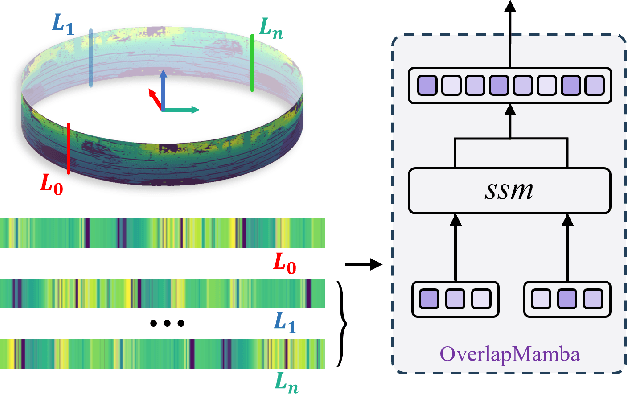

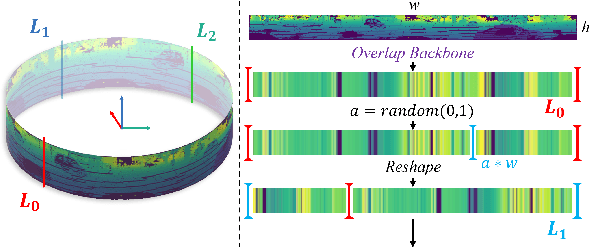
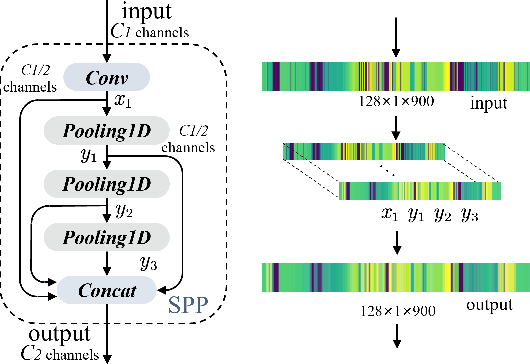
Abstract:Place recognition is the foundation for enabling autonomous systems to achieve independent decision-making and safe operations. It is also crucial in tasks such as loop closure detection and global localization within SLAM. Previous methods utilize mundane point cloud representations as input and deep learning-based LiDAR-based Place Recognition (LPR) approaches employing different point cloud image inputs with convolutional neural networks (CNNs) or transformer architectures. However, the recently proposed Mamba deep learning model, combined with state space models (SSMs), holds great potential for long sequence modeling. Therefore, we developed OverlapMamba, a novel network for place recognition, which represents input range views (RVs) as sequences. In a novel way, we employ a stochastic reconstruction approach to build shift state space models, compressing the visual representation. Evaluated on three different public datasets, our method effectively detects loop closures, showing robustness even when traversing previously visited locations from different directions. Relying on raw range view inputs, it outperforms typical LiDAR and multi-view combination methods in time complexity and speed, indicating strong place recognition capabilities and real-time efficiency.
 Add to Chrome
Add to Chrome Add to Firefox
Add to Firefox Add to Edge
Add to Edge